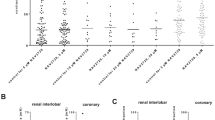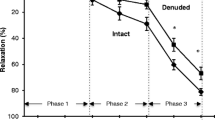Abstract
Nicotinamide adenine dinucleotide (NAD) belongs to the family of naturally occurring adenine dinucleotides, best known for their various intracellular roles. However, there is evidence that they can also be released from cells to act as novel extracellular signalling molecules. Relatively little is known about the extracellular actions of NAD, especially in the cardiovascular system. The present study investigated the actions of NAD in the rat thoracic aorta, porcine coronary artery and porcine mesenteric arteries, mounted in organ baths for isometric tension recording. In the rat thoracic aorta and porcine coronary artery, NAD caused endothelium-independent concentration-dependent vasorelaxations which were unaffected by palmitoylCoA, a P2Y1 receptor antagonist, but which were blocked by CGS15943, a non-selective adenosine receptor antagonist. In the porcine coronary artery, NAD-evoked relaxations were abolished by SCH58261, a selective A2A receptor antagonist. In the rat thoracic aorta, NAD-evoked relaxations were attenuated by A2A receptor antagonism with SCH58261 but were unaffected by an A2B receptor antagonist, MRS1754. In contrast, in the porcine mesenteric artery, NAD-evoked endothelium-independent contractions, which were unaffected by a P2 receptor antagonist, suramin, or by NF449, a P2X1 receptor antagonist, but were attenuated following P2X receptor desensitisation with αβ-meATP. In conclusion, the present results show that NAD can alter vascular tone through actions at purine receptors in three different arteries from two species; its molecular targets differ according to the type of blood vessel.









Similar content being viewed by others
References
Ralevic V, Burnstock G (1998) Receptors for purines and pyrimidines. Pharmacol Rev 50:413–492
Ralevic V (2009) Purines as neurotransmitters and neuromodulators in blood vessels. Curr Vasc Pharmacol 7(1):3–14
Burnstock G, Ralevic V (2014) Purinergic signaling and blood vessels in health and disease. Pharmacol Rev 66(1):102–192
Ralevic V (2012) P2X receptors in the cardiovascular system. WIREs Membr Transp Signal 1(5):663–674
Ziegler M (2000) New functions of a long-known molecule emerging roles of NAD in cellular signaling. Eur J Biochem 267(6):1550–1564
Ziegler M (2005) A vital link between energy and signal transduction. FEBS J 272(18):4561–4564
Lee HC (2001) Physiological functions of cyclic ADP-ribose and NAADP as calcium messengers. Annu Rev Pharmacol Toxicol 41:317–345
Smyth LM, Bobalova J, Mendoza MG, Lew C, Mutafova-Yambolieva VN (2004) Release of β-nicotinamide adenine dinucleotide upon stimulation of postganglionic nerve terminals in blood vessels and urinary bladder. J Biol Chem 279(47):48893–48903
Breen LT, Smyth LM, Yambolieva IA, Mutafova-Yambolieva VN, (2006) β-NAD is a novel nucleotide released on stimulation of nerve terminals in human urinary bladder detrusor muscle. Am J Physiol Renal Physiol 290(2):F486–95
Mutafova-Yambolieva VN, Hwang SJ, Hao X, Chen H, Zhu MX, Wood JD, Ward SM, Sanders KM (2007) β-nicotinamide adenine dinucleotide is an inhibitory neurotransmitter in visceral smooth muscle. Proc Natl Acad Sci U S A 104(41):16359–16364
Mutafova-Yambolieva VN (2012) Neuronal and extraneuronal release of ATP and NAD+ in smooth muscle. IUBMB Life 64(10):817–824
De Flora A, Zocchi E, Guida L, Franco L, Bruzzone S (2004) Autocrine and paracrine calcium signaling by the CD38/NAD+/cyclic ADP-ribose system. Ann N Y Acad Sci 1028:176–191
Bruzzone S, Guida L, Zocchi E, Franco L, De Flora A (2001) Connexin 43 hemichannels mediate Ca2+-regulated transmembrane NAD fluxes in intact cells. FASEB J 15(1):10–12
Romanello M, Bicego M, Pirulli D, Crovella S, Moro L, D’Andrea P (2002) Extracellular NAD+: a novel autocrine/paracrine signal in osteoblast physiology. Biochem Biophys Res Commun 299(3):424–431
Nikiforov A, Dölle C, Niere M, Ziegler M (2011) Pathways and subcellular compartmentation of NAD biosynthesis in human cells: From entry of extracellular precursors to mitochondrial NAD generation. J Biol Chem 286(24):21767–21778
Burnstock G, Hoyle CH (1985) Actions of adenine dinucleotides in the guinea-pig taenia coli: NAD acts indirectly on P1-purinoceptors; NADP acts like a P2-purinoceptor agonist. Br J Pharmacol 84(4):825–831
Hoyle CH (1990) Pharmacological activity of adenine dinucleotides in the periphery: possible receptor classes and transmitter function. Gen Pharmacol 21(6):827–831
Ralevic V, Hoyle CH, Burnstock G (1995) Pivotal role of phosphate chain length in vasoconstrictor versus vasodilator actions of adenine dinucleotides in rat mesenteric arteries. J Physiol 483(Pt 3):703–713
Cosker F, Cheviron N, Yamasaki M, Menteyne A, Lund FE, Moutin MJ, Galione A, Cancela JM (2010) The ecto-enzyme CD38 is a nicotinic acid adenine dinucleotide phosphate (NAADP) synthase that couples receptor activation to Ca2+ mobilization from lysosomes in pancreatic acinar cells. J Biol Chem 285(49):38251–38259
Berthelier V, Tixier JM, Muller-Steffner H, Schuber F, Deterre P (1998) Human CD38 is an authentic NAP(P)+ glycohydrolase. Biochem J 330(Pt 3):1383–1390
Moreschi I, Bruzzone S, Nicholas RA, Fruscione F, Sturla L, Benvenuto F, Usai C, Meis S, Kassack MU, Zocchi E, De Flora A (2006) Extracellular NAD+ is an agonist of the human P2Y1 purinergic receptor in human granulocytes. J Biol Chem 281(42):31419–31429
Grahnert A, Klein C, Hauschildt S (2009) Involvement of P2X receptors in the NAD+-induced rise in [Ca2+]i in human monocytes. Purinergic Signal 5(3):309–319
Alefishat E, Alexander SP, Ralevic V (2013) Antagonism of P2Y1-induced vasorelaxation by acyl CoA: a critical role for palmitate and 3′-phosphate. Br J Pharmacol 168(8):1911–1922
Hansmann G, Bültmann R, Tuluc F, Starke K (1997) Characterization by antagonists of P2-receptors mediating endothelium-dependent relaxation in the rat aorta. Naunyn Schmiedebergs Arch Pharmacol 356(5):641–652
Rose’Meyer RB, Hope W (1990) Evidence that A2 purinoceptors are involved in endothelium-dependent relaxation of the rat thoracic aorta. Br J Pharmacol 100(3):576–580
Balwierczak JL, Sharif R, Krulan CM, Field FP, Weiss GB, Miller MJ (1991) Comparative effects of a selective adenosine A2 receptor agonist, CGS 21680, and nitroprusside in vascular smooth muscle. Eur J Pharmacol 196(2):117–123
Merkel LA, Lappe RW, Rivera LM, Cox BF, Perrone MH (1992) Demonstration of vasorelaxant activity with an A1-selective adenosine agonist in porcine coronary artery: involvement of potassium channels. J Pharmacol Exp Ther 260(2):437–443
Monopoli A, Conti A, Zocchi C, Casati C, Volpini R, Cristalli G, Ongini E (1994) Pharmacology of the new selective A2a adenosine receptor agonist 2-hexynyl-5′-N-ethylcarboxamidoadenosine. Arzneimittelforschung 44(12):1296–1304
Abebe W, Makujina SR, Mustafa SJ (1994) Adenosine receptor-mediated relaxation of porcine coronary artery in presence and absence of endothelium. Am J Physiol 266(5 Pt 2):H2018–H2025
Olivecrona GK, Gotberg M, Harnek J, Wang L, Jacobson KA, Erlinge D (2004) Coronary artery reperfusion: the ADP receptor P2Y1 mediates early reactive hyperemia in vivo in pigs. Purinergic Signal 1(1):59–65
Rayment SJ, Latif ML, Ralevic V, Alexander SPH (2007) Evidence for the expression of multiple uracil nucleotide-stimulated P2 receptors coupled to smooth muscle contraction in porcine isolated arteries. Br J Pharmacol 150(5):604–612
Coddou C, Loyola G, Boyer JL, Bronfman M, Huidobro-Toro JP (2003) The hypolipidemic drug metabolites nafenopin-CoA and ciprofibroyl-CoA are competitive P2Y1 receptor antagonists. FEBS Lett 536(1–3):145–150
Manolopoulos P, Glenn JR, Fox SC, May JA, Dovlatova NL, Tang SW, Thomas NR, Ralevic V, Heptinstall S (2008) Acyl derivatives of coenzyme A inhibit platelet function via antagonism at P2Y1 and P2Y12 receptors: a new finding that may influence the design of anti-thrombotic agents. Platelets 19(2):134–145
Stone TW (1981) Actions of adenine dinucleotides on the vas deferens, guinea-pig taenia caeci and bladder. Eur J Pharmacol 75(2–3):93–102
Muller-Steffner HM, Malver O, Hosie L, Oppenheimer NJ, Schuber F (1992) Slow-binding inhibition of NAD+ glycohydrolase by arabino analogues of β-NAD+. J Biol Chem 267(14):9606–9611
Shatarat, A., Dunn, W.R., Ralevic, V., Raised tone reveals ATP as a sympathetic neurotransmitter in the porcine mesenteric arterial bed. Purinergic Signalling, in press
Gitterman DP, Evans RJ (2000) Properties of P2X and P2Y receptors are dependent on artery diameter in the rat mesenteric bed. Br J Pharmacol 131(8):1561–1568
Judkins CP, Sobey CG, Dang TT, Miller AA, Dusting GJ, Drummond GR (2006) NADPH-induced contractions of mouse aorta do not involve NADPH oxidase: a role for P2X receptors. J Pharmacol Exp Ther 317(2):644–650
Sun L, Adebanjo OA, Moonga BS, Corisdeo S, Anandatheerthavarada HK, Biswas G, Arakawa T, Hakeda Y, Koval A, Sodam B, Bevis PJ, Moser AJ, Lai FA, Epstein S, Troen BR, Kumegawa M, Zaidi M (1999) CD38/ADP-ribosyl cyclase: a new role in the regulation of osteoclastic bone resorption. J Cell Biol 146(5):1161–1172
Verderio C, Bruzzone S, Zocchi E, Fedele E, Schenk U, De Flora A, Matteoli M (2001) Evidence of a role for cyclic ADP-ribose in calcium signalling and neurotransmitter release in cultured astrocytes. J Neurochem 78(3):646–657
Esguerra M, Miller RF (2002) CD38 expression and NAD+-induced intracellular Ca2+ mobilization in isolated retinal Muller cells. Glia 39(3):314–319
Gerth A, Nieber K, Oppenheimer NJ, Hauschildt S (2004) Extracellular NAD+ regulates intracellular free calcium concentration in human monocytes. Biochem J 382(Pt 3):849–856
Pfister M, Ogilvie A, da Silva CP, Grahnert A, Guse AH, Hauschildt S (2001) NAD degradation and regulation of CD38 expression by human monocytes/macrophages. Eur J Biochem 268(21):5601–5608
Gustafsson AJ, Muraro L, Dahlberg C, Migaud M, Chevallier O, Khanh HN, Krishnan K, Li N, Islam MS (2011) ADP ribose is an endogenous ligand for the purinergic P2Y1 receptor. Mol Cell Endocrinol 333(1):8–19
Rubino A, Ralevic V, Burnstock G (1993) The P1-purinoceptors that mediate the prejunctional inhibitory effect of adenosine on capsaicin-sensitive nonadrenergic noncholinergic neurotransmission in the rat mesenteric arterial bed are of the A1 subtype. J Pharmacol Exp Ther 267(3):1100–1104
Rubino A, Ralevic V, Burnstock G (1995) Contribution of P1-(A2b subtype) and P2-purinoceptors to the control of vascular tone in the rat isolated mesenteric arterial bed. Br J Pharmacol 115(4):648–652
Acknowledgement
The support of the University of Jordan is gratefully acknowledged
Author information
Authors and Affiliations
Corresponding author
Rights and permissions
About this article
Cite this article
Alefishat, E., Alexander, S.P.H. & Ralevic, V. Effects of NAD at purine receptors in isolated blood vessels. Purinergic Signalling 11, 47–57 (2015). https://doi.org/10.1007/s11302-014-9428-1
Received:
Accepted:
Published:
Issue Date:
DOI: https://doi.org/10.1007/s11302-014-9428-1




